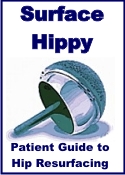Knees for You Patient Guide to Knee Replacement -
Home Page
About
About Knees For You
Updated 4/5/09
I started to have knee problems when I was 30 years old. I spent several weeks on crutches when my left knee swelled up and I could not walk on my leg. The doctor back in 1974 could not find a problem, but decided to give me an arthroscopic examine of my knee. For some reason after they pumped the air into my knee for the x-ray, the knee decided it was time to recover. I was able to return to all the activities I loved including tennis.
About 15 years later in 1989, my knee began to become painful again while I was playing tennis. I tried shots, a special knee brace and some prescription NSAIDS. My knee would be fine as long as I was not playing tennis, so I thought the best solution was to give up tennis.
A few years later, in 1993, my left hip also began hurting. It seems that hips, knees and backs are all connected together and you never know which is causing the pain that you feel. I eventually had my hip replaced in 2006 and my knee has not bothered me much since then. Of course, I have not played tennis or really been very active except to walk a lot. I had my left hip resurfaced in March 2006. The operation is similar to a total hip replacement, but it is a modern version that does not cut off your femur bone. There are no restrictions to your activities after surgery. The surgeon told me that getting my hip replaced would lengthen my leg back to where it should be and eventually help my back and knee problems.
I have a large
Patient to Patient website about Hip Resurfacing called Surface Hippy. It is very well used since people are looking for information and options for hip replacement. It is not controlled by any medical manufactures or companies, so the information is not biased.
I thought a similar patient to patient website about knee pain and knee replacement would also be a great resource for people. A place to read about what is new, medical studies, articles and other information.
Patricia Walter
Contact Patricia This email address is being protected from spambots. You need JavaScript enabled to view it.

Helpful Joint Websites
Helpful Websites about Knees, Backs, Joints and other related information
Knee Websites
Knee Devices by Manufacturer
Hip Websites
Back Websites
Welcome to Knees for You
The most difficult obstacle to resolving knee pain and possibly receiving a knee replacement is finding good, unbiased information. Doctors sometimes tend to be too busy to take time to explain things in depth and clearly. Sometimes there are other alternatives which some doctors don't believe in or don't know about, yet could be the perfect solution to your problem. That is the purpose of Knees for You Knee Replacement Guide - to give a patient information about knee replacement.
I had a hip resurfacing in 2006. Many doctors at the time did not know about hip resurfacing and many did not want to train to learn the difficult surgery, so the way I learned about hip resurfacing was thru the internet and discussion groups. There are often new approaches to solving problems that some doctors have not been trained in or have chosen not to accept - that does not mean it is not right for your problem. Therefore, I started the Knees for You Guide to Knee Replacement to help give perspective patients information about many aspects of knee replacement. Having good information will help you decide what you think is the right solution to your problem. It will, also, help you understand what your doctor is suggesting.
Want to post your questions and stories to other knee patients? Want support after knee surgery during your recovery?
Join the Knee Talk Discussion Group
There are three basic types of knee replacements:
Fixed Bearing Total Knee Systems: Both sides of the knee (the inside or medial compartment and outside or lateral compartment) are replaced in a single total knee replacement procedure, and with this type of device the plastic insert is fixed in place.
Mobile Bearing Total Knee Systems: Similar to that above, but with a plastic insert which is able to move within the joint, allowing more natural and complex knee movements and possibly creating less wear.
Unicompartmental Knee Systems: This type of replacement is used where disease is limited to one compartment in the knee, and is effectively a "half-knee" replacement.
There are many types of knees available and approaches to the surgery, but how does a patient decide what is best for them? Dr. Waldman suggests:
"Multiple studies have shown that the overall success in knee replacement can be traced to the surgeon and the team that cares for the patient during and after surgery. Surgeons and centers that do large numbers of implants have more success, on the average, than surgeons who do this type of surgery less often. When considering a doctor, it's important to ask how many operations of this type they do each year and what their personal outcomes are. The hospital they use should have a dedicated joint center and do a large number of joint replacements each year. It is also important to find a physician that responds in a timely manner to phone calls and patient requests."
You can read Dr. Waldman's complete article here: What Should A Patient Know?
Read and learn as much as you can. The more information you know, the better prepared you will be to ask questions of your doctor and make a good decision about your knee pain and knee replacement.
Related Articles
Health News
Latest Articles
- Vitamin D for Symptamotic Osteoarthritis Study
- MAKOplasty® Partial Knee Resurfacing Animation
- Oxford Unicompartmental Knee Replacement by Prof. Murry
- Two-stage revision TKA shows good survival at 10 years mean follow-up
- TKA with Porous Tantalum Tibial Component Study
- Smith & Nephew Accuris Uni Knee Replacement
- Outpatient Surgery for MIS Total Knee Relplacement Study
- Oxford Knee Replacement by Dr. Bernabe



